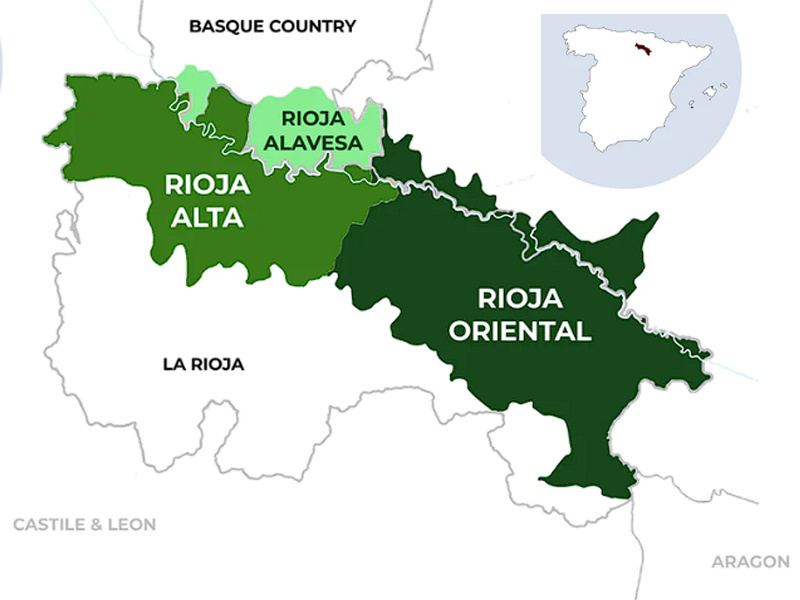Deep Dive into Rioja
- Posted on
- Posted in garnacha, spain, tempranillo
- 0

The Rioja wine region, nestled on a plateau in the northeastern corner of Spain, is a land of rich history, diverse terroirs, and unparalleled viticultural traditions. Spanning an altitude range of 300 to 800 meters, Rioja's landscape stretches approximately 60 miles along the northeastern banks of the Ebro River, from the enchanting city of Haro, in the northwest, to the picturesque town of Alfaro, in the southeast. This geographical diversity, coupled with its unique climatic conditions and political boundaries, contributes to the region's remarkable array of wines, each bearing the unmistakable stamp of Rioja's terroir.
Physically, Rioja is blessed with natural barriers that shape its climate and protect its vineyards. To the north, the majestic Sierra de Cantabria Mountains shield the region from the harsh Atlantic storms, while to the south, the Sierra de la Demanda and the Cameros Mountains provide a barrier against the warmer interior of Spain. These geographical features create a microclimate characterized by continental influences, and tempered by sub-regional variations. The Atlantic winds bring cooling damp air, while the Mediterranean winds carry warm, drying breezes, influencing the ripening process of Rioja's grapes, and contributing to the complexity of its wines.
Politically, Rioja's borders overlap with neighboring regions, adding to its cultural and viticultural tapestry. To the north, Rioja shares its boundary with the Basque Country, to the northeast with Navarra, and to the west and south with Castilla y León. This overlap reflects the region's historical and cultural connections with its neighbors, shaping its identity and contributing to the diversity of its winemaking traditions.
Internally, Rioja is subdivided into three distinct regions, each with its own unique characteristics and winemaking styles. The high-altitude Rioja Alta, situated to the west and south of the Ebro River, is renowned for its elegant wines, predominantly crafted from Tempranillo grapes. The region's elevated position allows for cooler temperatures, contributing to the grapes' acidity, color, and moderate sugar levels. With its clay, iron, and alluvial soils, Rioja Alta produces wines that are lighter in body, lower in acidity, and well-suited to oak and bottle aging, emphasizing finesse and elegance.
In contrast, Rioja Alavesa, the smallest of the three regions, lies on the northern side of the Ebro River, overlapping with the Basque province of Alava. Characterized by its chalky clay and limestone soils, and vineyards ranging from 400 to 1200 meters in elevation, Rioja Alavesa benefits from the Atlantic's cooling influence, resulting in wines with distinctive character and structure. Tempranillo dominates the plantings here, yielding wines that are often sold young, although some are aged in oak to enhance their complexity and depth.
On the eastern side of the Ebro River lies Rioja Oriental, formerly known as Rioja Baja, encompassing the lower and flatter terrain of the region. Vineyards here, situated between 550 and 1000 meters in elevation, experience the warm, dry Mediterranean winds, creating a unique microclimate that favors the cultivation of Garnacha, alongside Tempranillo and other red varietals. The region's silt and alluvial soils, combined with its lower elevation, contribute to the production of wines that are rich and full-bodied, with a focus on ripe fruit flavors and a balanced structure.
Throughout Rioja, vintage variation is a hallmark of winemaking, as each year brings its own climatic challenges and opportunities. While some producers strive for consistency across vintages through careful blending and winemaking techniques, others embrace the diversity of each growing season, crafting wines that express the unique character of their terroir and vintage. Whether it's the elegant wines of Rioja Alta, the characterful expressions of Rioja Alavesa, or the rich, full-bodied wines of Rioja Oriental, the wines of Rioja offer a glimpse into the region's rich winemaking heritage, and its enduring commitment to quality and tradition.

Comments
Be the first to comment...